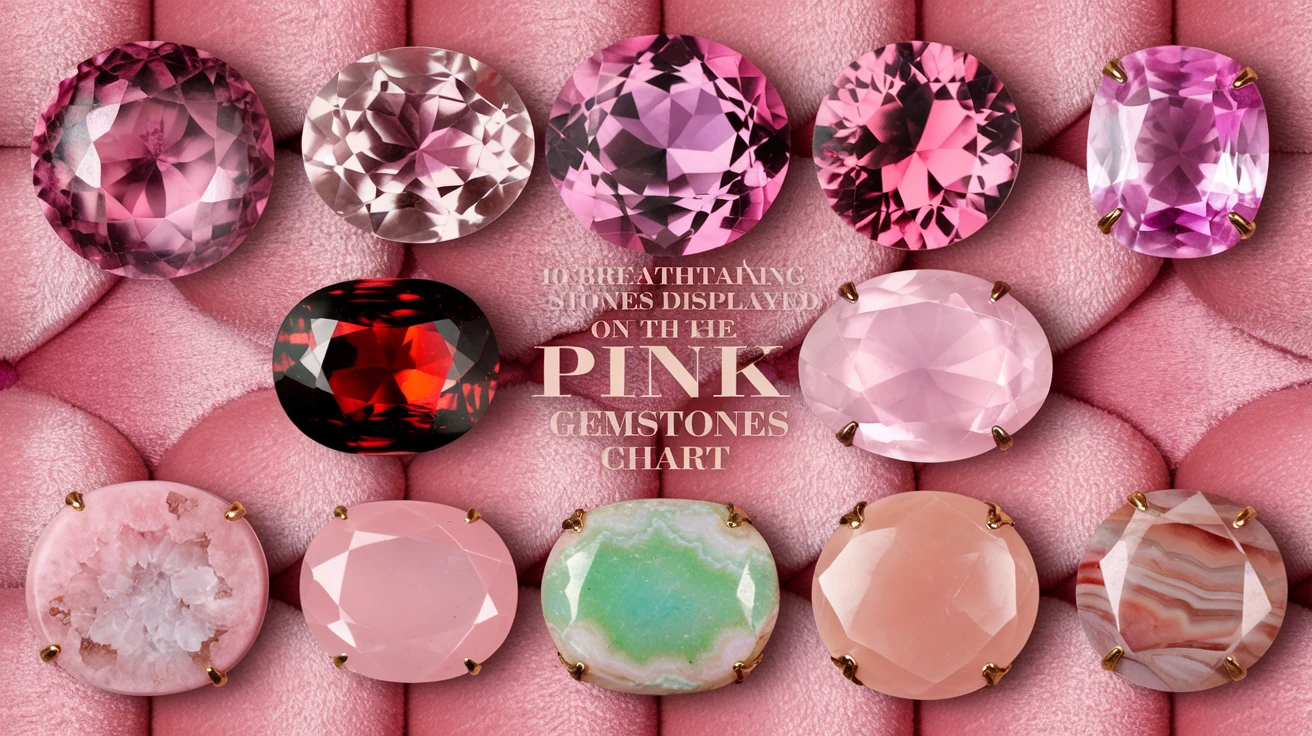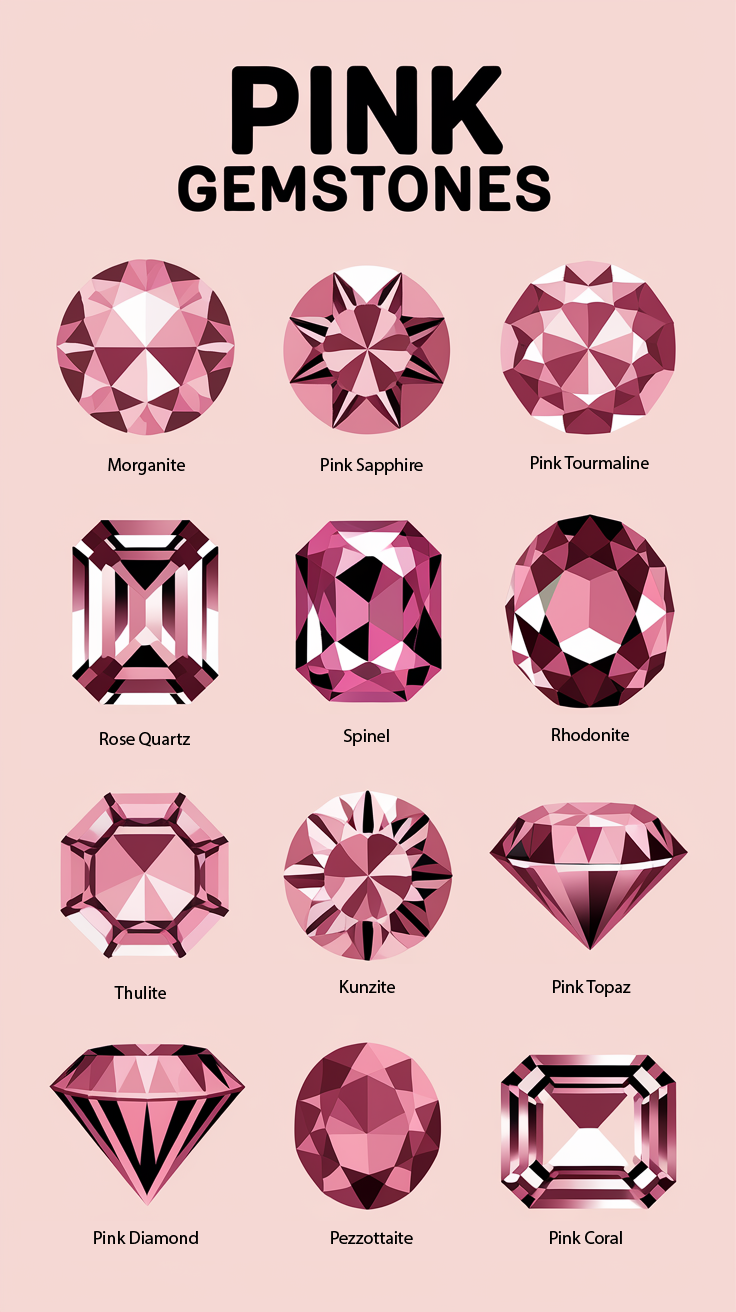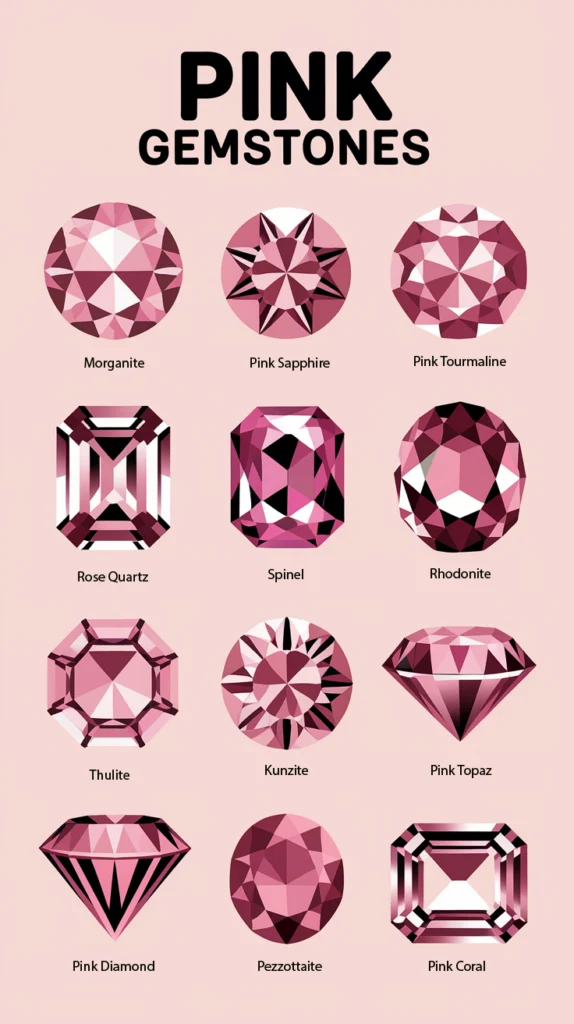
When it comes to the fascinating world of gemstones, pink varieties hold a special place in both collectors’ hearts and jewelry enthusiasts’ collections. These blush-toned beauties combine the strength of precious minerals with the soft, romantic allure of pink hues. As someone who’s spent years studying and working with gemstones, I’ve witnessed firsthand how pink gemstones can transform an ordinary piece of jewelry into something extraordinary. In this comprehensive guide, we’ll explore 10 stunning pink gemstones that frequently appear on gemological charts, each with its unique characteristics, value propositions, and enchanting stories.
Understanding the Allure of Pink Gemstones
Pink gemstones have captivated humans for millennia, and their popularity shows no signs of waning. Before we dive into specific stones, let’s examine what makes pink gemstones so special:
Color Classification
| Pink Intensity | Description | Value Impact |
|---|---|---|
| Very Light | Barely visible pink tint | Lower |
| Light | Soft, pastel pink | Moderate |
| Medium | Balanced pink hue | Higher |
| Deep | Rich, intense pink | Premium |
The Top 10 Pink Gemstones
1. Pink Sapphire: The Royal Beauty
Pink sapphires represent the perfect marriage of durability and beauty. During my visit to a gem show in Tucson, I was amazed by their range of pink hues, from soft baby pink to rich magenta. These stones rank 9 on the Mohs scale, making them ideal for everyday wear.
2. Morganite: The Ethereal Pink Beryl
Part of the beryl family, Morganite’s soft peachy-pink color has gained tremendous popularity in recent years. I remember my first Morganite purchase – I was initially skeptical about its pale color, but under proper lighting, it displayed an incredible three-dimensional depth.
3. Pink Tourmaline: The Electric Pink
| Quality Factor | Characteristics | Value Impact |
|---|---|---|
| Color | Hot pink to pale pink | High |
| Clarity | Usually included | Moderate |
| Cut | Often elongated | Medium |
4. Pink Diamond: The Ultimate Luxury
These rare beauties command the highest prices among pink gemstones. Their scarcity and hardness make them particularly valuable, with some pink diamonds selling for millions per carat.
5. Rose Quartz: The Stone of Love
– Most abundant pink gemstone
– Known for its healing properties
– Typically translucent rather than transparent
– Affordable and widely available
6. Pink Topaz: The Brilliant Pink
Natural pink topaz is relatively rare, though treated versions are more common. Its excellent hardness (8 on Mohs scale) makes it suitable for all jewelry types.
7. Pink Spinel: The Misidentified Gem
– Often confused with ruby and sapphire historically
– Completely natural – rarely treated
– Outstanding brilliance and durability
– Growing rapidly in popularity
8. Kunzite: The Delicate Pink
This delicate gem requires special care due to its perfect cleavage. Its color can fade in strong sunlight, but proper care maintains its beautiful lilac-pink hue.
9. Pink Opal: The Mystical Pink
Unlike its more common white counterpart, pink opal offers a unique combination of opacity and color play that makes it particularly intriguing.
10. Rhodochrosite: The Banded Beauty
Though primarily a collector’s stone, rhodochrosite’s distinctive pink and white banding makes it a standout in any collection.
Practical Care and Maintenance Tips
| Gemstone | Cleaning Method | Special Care Notes |
|---|---|---|
| Sapphire & Diamond | Ultrasonic safe | Heat resistant |
| Morganite & Topaz | Warm soapy water | Avoid harsh chemicals |
| Kunzite & Opal | Soft brush only | No ultrasonic/heat |
Investment and Value Considerations
When investing in pink gemstones, consider these essential factors:
– Rarity and availability
– Color intensity and uniformity
– Clarity characteristics
– Cut quality and precision
– Market demand and trends
– Certificate authenticity
Conclusion
The world of pink gemstones offers something for every collector, from the affordable rose quartz to the ultra-rare pink diamond. Through my years of experience, I’ve learned that each pink gemstone has its own story and charm. Whether you’re starting your collection or adding to an existing one, understanding these ten remarkable stones will help you make informed decisions and appreciate their unique beauty.
Key Takeaways
- Pink gemstones vary significantly in hardness, value, and durability
- Proper care and maintenance are essential for preserving their beauty
- Natural pink stones generally command higher prices than treated ones
Frequently Asked Questions
What is the most valuable pink gemstone?
Pink diamonds are typically the most valuable pink gemstones, with exceptional specimens selling for millions of dollars per carat.
Are all pink gemstones natural?
Not all pink gemstones are natural. Some, like certain pink topaz, undergo treatment to enhance their color. Always ask about treatments when purchasing.
How can I tell if a pink sapphire is real?
Real pink sapphires should be examined by a certified gemologist. They typically show strong pleochroism and have specific gravity and refractive index measurements.
What’s the most affordable pink gemstone?
Rose quartz is typically the most affordable pink gemstone, offering beautiful color at accessible prices.
Can pink gemstones fade over time?
Some pink gemstones, particularly kunzite and certain tourmalines, can fade if exposed to strong sunlight for extended periods.
What’s the difference between pink sapphire and pink ruby?
Pink sapphires and rubies are both corundum, but rubies must meet a specific color intensity threshold to be classified as rubies rather than pink sapphires.
Are pink diamonds naturally pink?
Natural pink diamonds get their color from a crystal structure distortion. Some pink diamonds are treated to enhance their color.
Which pink gemstone is best for everyday wear?
Pink sapphire is excellent for everyday wear due to its hardness (9 on Mohs scale) and durability.
How should I store my pink gemstones?
Store pink gemstones separately in soft pouches or compartmented boxes to prevent scratching, and keep them away from direct sunlight.
What causes the pink color in gemstones?
Pink colors in gemstones can be caused by various factors, including trace elements like chromium, manganese, or titanium, or structural phenomena in the crystal.


